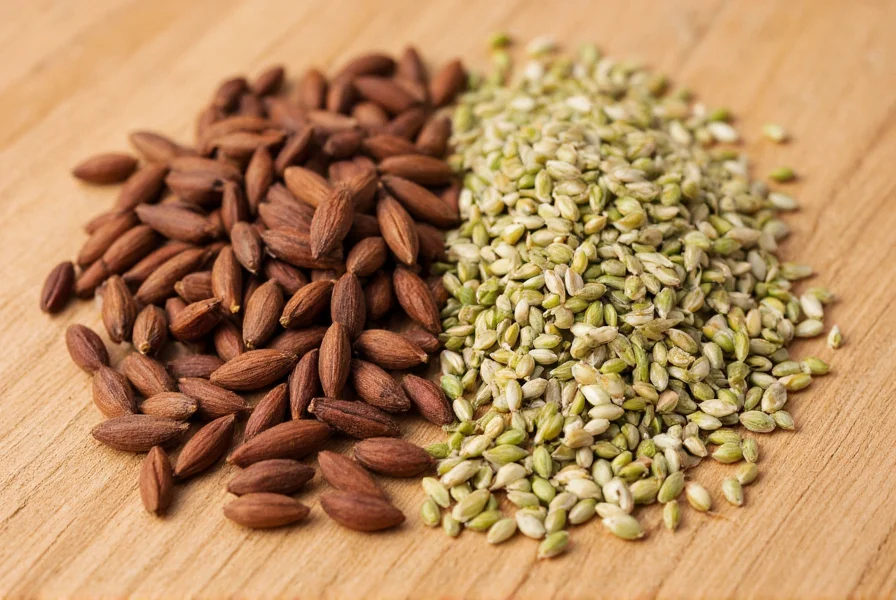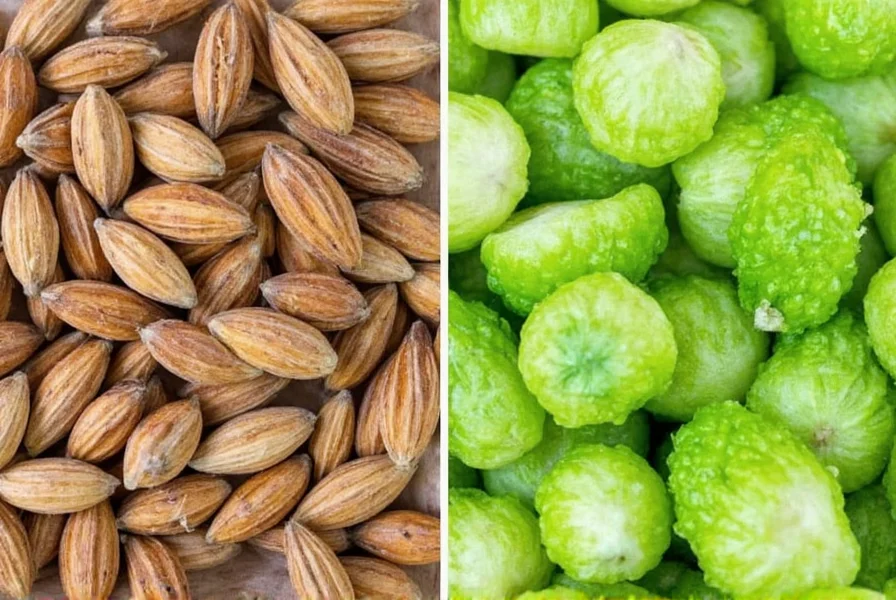Many home cooks confuse anise and fennel due to their similar licorice-like flavors, but understanding their differences can transform your culinary creations. These two botanical cousins belong to the same plant family (Apiaceae) yet serve distinct purposes in cooking, gardening, and traditional medicine. Getting them right matters—using one when a recipe calls for the other can dramatically alter your dish's flavor profile.
Botanical Distinctions: More Than Just Confusing Cousins
Anise (Pimpinella anisum) is an annual herb native to the eastern Mediterranean and Southwest Asia. Only its small, grayish-brown seeds are commonly used in cooking. In contrast, fennel (Foeniculum vulgare) is a hardy perennial plant with multiple culinary components: the bulb (often called Florence fennel), feathery fronds, and seeds.
While both contain anethole—the compound responsible for licorice flavor—fennel contains significantly less, resulting in a milder taste. Anise seeds measure approximately 3-5mm long with a distinct curved shape, whereas fennel seeds are longer (5-10mm) and straighter with a greenish hue when fresh.
| Characteristic | Anise | Fennel |
|---|---|---|
| Botanical Name | Pimpinella anisum | Foeniculum vulgare |
| Plant Type | Annual herb | Perennial herb |
| Primary Culinary Parts | Seeds only | Bulb, seeds, fronds |
| Anethole Content | High (80-90%) | Moderate (50-60%) |
| Flavor Intensity | Strong, sweet | Milder, slightly vegetal |
Flavor Profiles: When Substitution Works (and When It Doesn't)
Anise delivers an intense, almost sweet licorice punch that stands up well in baked goods and liqueurs. Its flavor remains potent even when cooked. Fennel offers a more nuanced profile—its seeds provide gentle licorice notes while the bulb contributes subtle sweetness with celery-like undertones.
Understanding anise seed vs fennel bulb applications is crucial. The bulb works beautifully raw in salads or roasted as a vegetable side, while anise seeds would overwhelm these applications. Conversely, anise's stronger flavor makes it preferable for spice blends like Chinese five-spice or Middle Eastern baharat.
When considering can I substitute fennel for anise, remember: you can generally replace anise with fennel seeds at a 2:1 ratio (use twice as much fennel), but the reverse substitution rarely works due to anise's potency. For recipes calling for fennel bulb, no anise product serves as an adequate substitute.
Culinary Applications: Maximizing Each Ingredient's Strengths
Anise shines in applications where its bold flavor can dominate:
- Classic Italian biscotti and pizzelle
- German springerle cookies
- Ouzo, absinthe, and other anise-flavored liqueurs
- Indian and Middle Eastern spice blends
Fennel's versatility spans multiple plant parts:
- Bulb: Shaved raw in salads, roasted as a side dish, braised in stews
- Fronds: Chopped as herb garnish (similar to dill)
- Seeds: In Italian sausage, pickling brines, and breads
For those exploring culinary uses of anise versus fennel, consider this rule: when a recipe specifies "fennel," it likely means the bulb unless seeds are specified. "Anise" almost always refers to the seeds.
Nutritional Comparison and Health Considerations
Both offer digestive benefits, but their anise and fennel nutritional benefits differ. Anise seeds contain higher concentrations of certain compounds:
- Anise: Rich in manganese, calcium, and iron; traditionally used for respiratory relief and menstrual discomfort
- Fennel: Higher in vitamin C and potassium; bulb provides dietary fiber; commonly used as natural breath freshener
Those with estrogen-sensitive conditions should consult physicians before consuming large amounts of anise, which contains phytoestrogens. Fennel is generally considered safer for regular consumption, though both should be used in culinary amounts rather than medicinally without professional guidance.

Storage and Preparation Tips
Proper storage preserves their distinct flavors:
- Anise seeds: Store in airtight container away from light; retains potency for 2 years
- Fennel bulb: Wrap in paper towel inside plastic bag; refrigerate up to 5 days
- Fennel seeds: Store like anise but lose potency faster (1-1.5 years)
Toast both seeds briefly in a dry pan to enhance their flavors before use. For fresh fennel bulb, remove the tough outer layer and trim the stalk end before slicing.
Common Misconceptions Clarified
Many confuse anise fennel star anise differences. Star anise (Illicium verum) is a completely different plant (native to China) with a star-shaped fruit. While all three share licorice notes, star anise has more complex flavor with subtle bitterness.
Another frequent error: assuming fennel and dill are interchangeable. While both have feathery fronds, their flavors differ significantly—dill offers grassy, citrus notes versus fennel's licorice character.

Practical Substitution Guidelines
When ingredient substitutions become necessary:
- Anise seed substitute: Use 1.5x fennel seeds + pinch of star anise (for baked goods)
- Fennel bulb substitute: Celery +茴香 fronds (if available) + slight anise seed sprinkle
- Fennel seed substitute: Dill seed (for pickling) or anise seed at 50% strength
Remember that growing anise vs fennel plants requires different conditions—anise grows best in warm, dry climates as an annual, while fennel thrives as a perennial in temperate zones and can become invasive.
Conclusion: Mastering the Anise-Fennel Distinction
Understanding the difference between anise and fennel seeds elevates your cooking from accidental to intentional. While their shared licorice notes create understandable confusion, recognizing anise's potent sweetness versus fennel's milder versatility allows precise flavor control. Keep anise for bold applications where licorice should shine, and reach for fennel when subtlety or multiple plant parts are needed. With this knowledge, you'll confidently navigate recipes calling for either—and know exactly when substitution might work.
Frequently Asked Questions
Can I use fennel seeds instead of anise in baking?
Yes, but use 1.5-2 times the amount of fennel seeds since they're milder. For best results in cookies or breads, add a tiny pinch of star anise to approximate anise's intensity. Note that the final product will have more subtle licorice notes.
Is fennel bulb the same as anise bulb?
No. Fennel produces an edible bulb (often called Florence fennel), while anise is grown only for its seeds—the plant doesn't form an edible bulb. When recipes mention "fennel" without specification, they typically mean the bulb.
Which is better for digestion: anise or fennel?
Both aid digestion, but fennel tea is generally preferred for immediate relief due to its milder nature. Anise contains more potent compounds that may be too strong for sensitive stomachs. Fennel's versatility (bulb, seeds, tea) makes it more practical for regular digestive support.
Can I grow anise and fennel together in a garden?
It's not recommended. Both belong to the Apiaceae family and can cross-pollinate, potentially creating hybrid plants with unpredictable flavors. Fennel is particularly invasive and may dominate garden space. If growing both, maintain at least 1/4 mile separation or use physical barriers.
Why do some recipes call for both anise and fennel?
Combining both creates layered licorice notes—fennel provides subtle background flavor while anise delivers the prominent punch. This technique appears in traditional Italian sausage recipes and certain Mediterranean breads where complexity matters more than a single-note licorice flavor.











 浙公网安备
33010002000092号
浙公网安备
33010002000092号 浙B2-20120091-4
浙B2-20120091-4